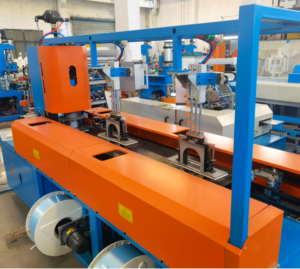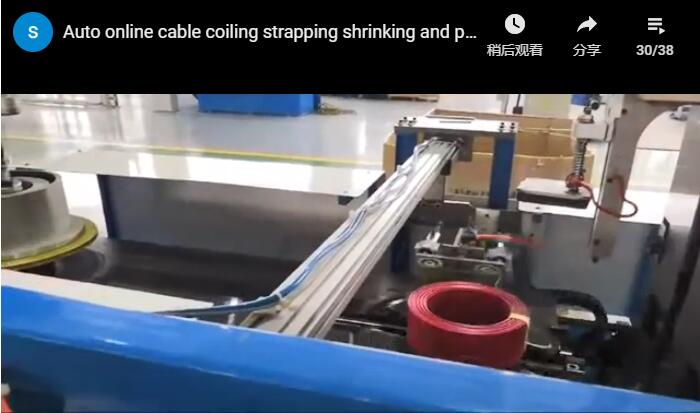Streamlining Cable Handling: A Technical Look at Automated Coiling, Strapping, Shrinking, and Stacking Lines
In today's demanding manufacturing environment, efficiency, consistency, and safety in cable and wire handling are paramount. Manual or semi-automated processes often struggle to keep pace, introducing variability, potential ergonomic risks, and increased labor costs. Fully automated packaging lines, integrating multiple processes from coiling to stacking, offer a robust solution. This article delves into the technical aspects, design considerations, and operational benefits of a comprehensive automated cable packaging system, exemplified by the integrated line showcased above.

1. The Imperative for Automation in Cable Packaging
Traditional cable handling involves several distinct manual steps: measuring and cutting, coiling or winding onto spools, securing the coil, protective wrapping, and finally, stacking or palletizing for shipment. Each step presents challenges:
- Inconsistency: Manual coiling can lead to variations in coil diameter, density, and overall presentation.
- Labor Intensity: Significant manpower is required, diverting skilled labor from other value-added tasks.
- Ergonomic Risks: Repetitive motions in handling heavy or bulky cables can lead to musculoskeletal injuries.
- Throughput Limitations: Manual processes inherently cap the speed and volume of cable packaging operations.
- Material Waste: Inconsistent wrapping or strapping can lead to excess material usage.
An integrated automated line addresses these points directly by creating a seamless, efficient workflow.
2. System Overview: An Integrated Workflow
The core concept is a modular production line where cable moves sequentially through automated stations without manual intervention. A typical high-performance line incorporates:
- Precision Coiling/Winding: Automatically forms neat, consistent coils based on pre-set parameters.
- Automated Strapping: Secures the coil using materials like PP or PET strapping.
- Heat Shrink Wrapping: Applies and shrinks a protective polymer film around the strapped coil.
- Robotic Stacking/Palletizing: Arranges the finished coils onto pallets or into containers according to programmed patterns.
This end-to-end automation ensures consistent quality, high throughput, and minimal operator involvement.
3. Deep Dive into Process Stages and Components
3.1. Automated Cable Coiling
The process begins with precise measurement and coiling. Key technical aspects include:
- Traversing System: Ensures level winding for stable, dense coils. Servo-driven traversing offers high accuracy and repeatability.
- Coiling Head: Designed for specific cable types and diameters. Quick-change features may be available for handling different product runs.
- Tension Control: Critical for preventing cable damage and ensuring coil integrity. Sophisticated systems use dancers or load cells with feedback loops to maintain consistent tension.
- Cutting Mechanism: Integrated cutters provide clean, precise cuts at the programmed length.
3.2. Coil Strapping Unit
Once coiled, the product is transferred to the strapping station:
- Strapping Head: Industrial-grade heads designed for reliability and speed, often using heat-sealing or friction-weld technology.
- Strap Material: Typically accommodates Polypropylene (PP) or Polyester (PET) strapping of various widths and thicknesses.
- Strap Placement: Programmable logic controllers (PLCs) ensure accurate strap placement (e.g., 2, 3, or 4 straps per coil) at consistent tension.
3.3. Shrink Wrapping Module
For enhanced protection and unitization:
- Film Application: Automatically dispenses and seals shrink film (often PE - Polyethylene) around the coil.
- Heat Tunnel: Precisely controlled temperature and airflow ensure uniform shrinking without damaging the cable insulation. Tunnel dimensions and heating element power (kW) are key specifications based on throughput and product size.
- Conveyor System: Heat-resistant conveyors (e.g., mesh belt or rollers) transport the product through the tunnel.
3.4. Stacking and Palletizing
The final stage involves automated handling:
- Robotic Arm: Typically a 4-axis or 6-axis robot equipped with a specialized gripper designed for handling coils.
- Pattern Programming: Easily configurable stacking patterns via the Human-Machine Interface (HMI).
- Pallet Dispenser (Optional): Automatically feeds empty pallets into the stacking zone.
- Safety Fencing: Essential guarding around the robotic cell to comply with safety standards (e.g., ISO 10218).
automatic cable winding and packing line 2000x1500 4. Key Technical Specifications & Performance Data
When evaluating such a system, fabricators should consider the following parameters:
- Cable Diameter Range: e.g., Ø5mm - Ø50mm
- Maximum Coil Weight: e.g., 5kg - 100kg
- Coil Outer Diameter (OD): e.g., 200mm - 800mm
- Coil Inner Diameter (ID): e.g., 100mm - 400mm
- Coiling Speed: e.g., Up to 150 m/min (variable based on cable type and coil size)
- Strapping Cycle Time: e.g., 10-20 seconds per coil (depending on number of straps)
- Shrink Tunnel Throughput: Matched to the coiling and strapping speed.
- Stacking Capacity: Defined by robot payload and cycle time, e.g., up to 6-10 coils/minute.
- Control System: PLC (e.g., Siemens, Allen-Bradley) with Touchscreen HMI.
- Power Requirements: Voltage/Phase/Frequency (e.g., 480V/3Ph/60Hz), Total Connected Load (kW).
- Compressed Air: Pressure (bar/psi) and Consumption (L/min or CFM).
(Note: These are example ranges; actual specifications vary significantly by manufacturer and model.)
5. Design, Construction, and Compliance
A well-engineered line prioritizes:
- Modularity: Allows for easier customization, installation, and future upgrades.
- Robust Construction: Heavy-duty steel frames and high-quality components ensure longevity in industrial environments.
- Safety Integration: Comprehensive safety features including light curtains, emergency stops, safety interlocks on access doors, and guarding compliant with CE or relevant regional standards.
- User Interface (HMI): Intuitive touchscreen interface for parameter setting, recipe management, diagnostics, and production monitoring.
Compliance with CE guidelines, as mentioned for the showcased system, signifies adherence to European safety, health, and environmental protection standards.
6. Personal Experience: Operational Advantages in Practice
From a user perspective, operating and maintaining such a line offers tangible benefits:
- Reduced Operator Strain: Eliminates heavy lifting and repetitive manual tasks, improving workplace ergonomics and safety.
- Consistent Output: Automation removes human variability, resulting in uniform coil dimensions, secure strapping, and professional package appearance every time.
- Increased Throughput: The system operates continuously at speeds often unachievable manually, significantly boosting production capacity.
- Labor Optimization: Frees up personnel for tasks requiring human judgment and skill, such as quality control, machine oversight, or setup for different cable types.
- Data Logging & Traceability: Modern systems often integrate with plant management software (MES/ERP) for production tracking and quality assurance.
- Simplified Changeovers: While initial setup requires expertise, well-designed HMIs and tooling allow for relatively quick changeovers between different cable specifications or packaging formats once recipes are stored.
- Maintenance: Routine maintenance typically involves lubrication, sensor checks, strap coil changes, and inspection of wear parts (cutters, sealing elements). Diagnostic screens on the HMI aid in troubleshooting.
7. Integration and Future Considerations
These automated lines are rarely standalone islands. Effective integration involves:
- Upstream Connectivity: Connection to extruders or pay-off systems for continuous cable feed.
- Downstream Logistics: Interface with automated guided vehicles (AGVs) or conveyor systems for transporting finished pallets.
- Industry 4.0 Readiness: Features like remote monitoring, predictive maintenance alerts, and data analytics capabilities are increasingly common, allowing for smarter factory operations.
Conclusion
Automated cable coiling, strapping, shrinking, and stacking lines represent a significant investment, but one that delivers substantial returns through increased efficiency, enhanced safety, improved product quality, and optimized labor utilization. By integrating these processes into a single, fluid system built with robust components, precise controls, and adherence to safety standards, manufacturers can gain a critical competitive edge in the demanding cable and wire market.
For more information on specific solutions:
www.fhopepack.com
Contact: coiler@fhopepack.com


